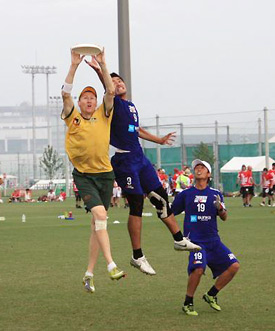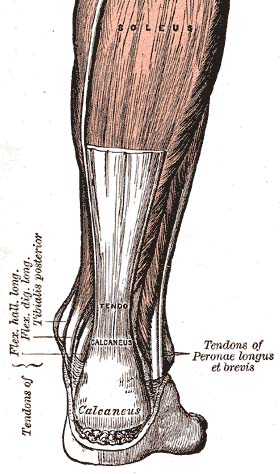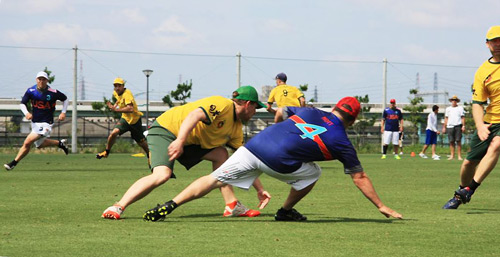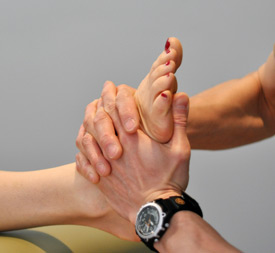Achilles Tendon Pain

Anatomy
The strongest tendon in the body conjoins the gastrocnemius and soleus muscles to the heel bone (calcaneous). The average length is about 15 cm and does not have a true synovial sheath covering and protecting it but rather a single cell layer of fatty areolar tissue called a paratenon. Blood supply is evident in three locations, being most vascular proximally where it attached to the muscles and least in the mid section of the tendon.
Common Causes
- Achilles Tendinitis / Bursitis
This is an inflammatory condition of the attachment of the achilles tendon / bursa to the heel bone called the calcaneous. - Achilles Tendinopathy
This is a non-inflammatory condition of the mid-section of the Achilles tendon. This area has increased tenderness on palpation versus the non-affected side. It is characterized by degenerative changes of the tendon (tendinosis). This is the more prevalent of the two types of Achilles tendon pain.

Prevalence
Achilles tendon disorders are reported in a wide variety of sports. Seen amongst a variety of athletics it is more symptomatic during training as opposed to during competition. It accounts for up to 9% in recreational & competitive runners. People who are less active are not immune to this either. Although there is an increased prevalence of Achilles injuries as age increases, the mean age for Achilles disorders is reported to be between 30-50 years of age.
Risk Factors for Achilles Tendinopathy
- Abnormal dorsiflexion range of motion (Specifically decreased dorsiflexion with the knee extended)
- Tendon structure as identified with diagnostic ultrasound imaging
- Abnormal range of motion in the hind-foot (subtalar joint)
- Decreased plantar flexion strength
- Increased foot pronation (flat feet)
- Possible Medical conditions: obesity, hypertension, hyperlipidemia, diabetes
- Extrinsic factors: (training errors, environmental factors, faulty equipment)

Diagnosis / Classification
- Localized pain / stiffness in Achilles tendon
- Intermittent pain related to activity or exercise
- Stiffness upon weight bearing after prolonged immobilization (such as sleeping)
- Stiffness & pain at the commencement of exercise training session that lessens as exercise continues. – As condition worsens a progression of pain may be felt at the end of the exercise session ro pain throughout the duration of activity occurs
- Decrease plantar flexion endurance
- Arc sign: area of palpated swelling moves with dorsiflexion & plantar flexion
- “Royal London Hospital Test”: positive when tenderness at 3 cm proximal to calcaneous with ankle in slight plantar flexion, that decreases as ankle is dorsiflexed
Other Possible Diagnoses
- Acute Achilles tendon rupture
- Partial tear of Achilles tendon
- Retrocalcaneal bursitis
- Posterior ankle impingment
- Irritation or neuroma of sural nerve
- Os trigonum syndrome
- Accessory soleus muscle
- Achilles tendon ossification
- Systemic Inflammatory disease
- Insertional Achilles tendinopathy

Is Additional Imaging Useful?
Likely that both ultrasound and MRI imaging will play an important role in verifying tendon structure to augment clinical decision-making.
Prognosis / Outcome
- Long-term prognosis for patients with acute-to-subchronic Achilles tendinopathy favourable with non-operative treatment. (Follow-up studies show 71% to 100% are able to return to prior level of activity
- Significant decreases in pain and improvement in function reported following 6 to 12 weeks of intervention
- If conservative therapy is unsuccessful, surgery recommended to remove fibrotic adhesions / degenerative nodules to restore vascularity – (Paavola et al found 29% of those with acute to subacute Achilles tendinopathy required surgical intervention with favourable outcome)
Treatment / Intervention

- Eccentric Loading – specifically designed strengthening program
- Stretching
- Foot Orthoses
- Hands-on Manual Therapy to restore ankle joint mobility and soft tissue release techniques
- Addressing other joint imbalances higher up: hip / SI joint & spine
- Taping
- Electric modalities
- Heel lifts
For more information about achilles tendon pain please contact InSync Physio.
References
- Ackermann PW, Salo PT, Hart DA. Neuronal pathways in tendon healing. Front Biosci. 2009;14:5165-5187.
- Alfredson H, Cook J. A treatment algorithm for managing Achilles tendinopathy: new treatment options. Br J Sports Med. 2007;41:211-216. http://dx.doi.org/10.1136/bjsm.2007.035543
- Alfredson H, Lorentzon R. Chronic Achilles tendinosis: recommendations for treatment and prevention. Sports Med. 2000;29:135-146.
- Alfredson H, Ohberg L. Sclerosing injections to areas of neo vascularisation reduce pain in chronic Achilles tendinopathy: a double-blind randomised controlled trial. Knee Surg Sports Traumatol Arthrosc. 2005;13:338-344. http://dx.doi.org/10.1007/s00167-004-0585-6
- Alfredson H, Pietila T, Jonsson P, Lorentzon R. Heavy-load eccentric calf muscle training for the treatment of chronic Achilles tendinosis. Am J Sports Med. 1998;26:360-366.
- Alfredson H, Thorsen K, Lorentzon R. In situ microdialysis in tendon tissue: high levels of glutamate, but not prostaglandin E2 in chronic Achilles tendon pain. Knee Surg Sports Traumatol Arthrosc. 1999;7:378-381.
- Ames PR, Longo UG, Denaro V, Maffulli N. Achilles tendon problems: not just an orthopaedic issue. Disabil Rehabil. 2008;30:1646-1650. http:// dx.doi.org/10.1080/09638280701785882
- Amiel D, Kuiper SD, Wallace CD, Harwood FL, VandeBerg JS. Age-related properties of medial collateral ligament and anterior cruciate ligament: a morphologic and collagen maturation study in the rabbit. J Gerontol.1991;46:B159-165.
- Andersson G, Danielson P, Alfredson H, Forsgren S. Nerve-related characteristics of ventral paratendinous tissue in chronic Achilles tendinosis. Knee Surg Sports Traumatol Arthrosc. 2007;15:1272-1279. http://dx.doi.org/10.1007/s00167-007-0364-2
- Astrom M, Rausing A. Chronic Achilles tendinopathy. A survey of surgical and histopathologic findings. Clin Orthop Relat Res. 1995;151-164.
- Barge-Caballero E, Crespo-Leiro MG, Paniagua-Martin MJ, et al. Quinolone-related Achilles tendinopathy in heart transplant patients: incidence and risk factors. J Heart Lung Transplant. 2008;27:46-51. http://dx.doi.org/10.1016/j.healun.2007.09.021
- Bjordal JM, Lopes-Martins RA, Iversen VV. A randomised, placebo controlled trial of low level laser therapy for activated Achilles tendinitis with microdialysis measurement of peritendinous prostaglandin E2 concentrations. Br J Sports Med. 2006;40:76-80; discussion 76-80. http://dx.doi.org/10.1136/bjsm.2005.020842
- Bjur D, Alfredson H, Forsgren S. The innervation pattern of the human Achilles tendon: studies of the normal and tendinosis tendon with markers for general and sensory innervation. Cell Tissue Res. 2005;320:201-206. http://dx.doi.org/10.1007/s00441-004-1014-3
- Bleakney RR, White LM. Imaging of the Achilles tendon. Foot Ankle Clin. 2005;10:239-254. http://dx.doi.org/10.1016/j.fcl.2005.01.006
- Brown R, Orchard J, Kinchington M, Hooper A, Nalder G. Aprotinin in the management of Achilles tendinopathy: a randomised controlled trial. Br J Sports Med. 2006;40:275-279. http://dx.doi.org/10.1136/bjsm.2005.021931
- Buckwalter JA, Woo SL, Goldberg VM, et al. Soft-tissue aging and musculoskeletal function. J Bone Joint Surg Am. 1993;75:1533-1548.
- Carr AJ, Norris SH. The blood supply of the calcaneal tendon. J Bone Joint Surg Br. 1989;71:100-101.
- Christenson RE. Effectiveness of specific soft tissue mobilizations for the management of Achilles tendinosis: single case study—experiexperimental design. Man Ther. 2007;12:63-71. http://dx.doi.org/10.1016/j.math.2006.02.012
- Clement DB, Taunton JE, Smart GW. Achilles tendinitis and peritendinitis: etiology and treatment. Am J Sports Med. 1984;12:179-184.
- Costa ML, Shepstone L, Donell ST, Thomas TL. Shock wave therapy for chronic Achilles tendon pain: a randomized placebo-controlled trial. Clin Orthop Relat Res. 2005;440:199-204.
- Cummins EJ, Anson BJ, Carr BW, Wright RR. The structure of the calcaneal tendon (of Achilles) in relation to orthopedic surgery: with additional observations on the plantaris muscle. Surg Gynecol Obstet.1946;83:107-116.
- Curwin S, Stanish W. Tendinitis: Its Etiology and Treatment. Lexington, MA: Collamore Press; 1984.
- DaCruz DJ, Geeson M, Allen MJ, Phair I. Achilles paratendonitis: an evaluation of steroid injection. Br J Sports Med. 1988;22:64-65.
- Damholt V, Termansen NB. Asymmetry of plantar flexion strength in the foot. Acta Orthop Scand. 1978;49:215-219.
- Donoghue OA, Harrison AJ, Laxton P, Jones RK. Orthotic control of rear foot and lower limb motion during running in participants with chronic Achilles tendon injury. Sports Biomech. 2008;7:194-205.
- Elveru RA, Rothstein JM, Lamb RL. Goniometric reliability in a clinical setting. Subtalar and ankle joint measurements. Phys Ther. 1988;68:672-677.
- Fahlstrom M, Jonsson P, Lorentzon R, Alfredson H. Chronic Achilles tendon pain treated with eccentric calf-muscle training. Knee Surg Sports Traumatol Arthrosc. 2003;11:327-333. http://dx.doi.org/10.1007/s00167-003-0418-z
- Fahlstrom M, Lorentzon R, Alfredson H. Painful conditions in the Achilles tendon region in elite badminton players. Am J Sports Med. 2002;30:51-54.
- Fordham S, Garbutt G, Lopes P. Epidemiology of injuries in adventure racing athletes. Br J Sports Med. 2004;38:300-303.
- Fredberg U, Bolvig L. Significance of ultrasonographically detected asymptomatic tendinosis in the patellar and achilles tendons of elite soccer players: a longitudinal study. Am J Sports Med. 2002;30:488-491.
- Gardin A, Bruno J, Movin T, Kristoffersen-Wiberg M, Shalabi A. Magnetic resonance signal, rather than tendon volume, correlates to pain and functional impairment in chronic Achilles tendinopathy. Acta Radiol. 2006;47:718-724. http://dx.doi.org/10.1080/02841850600774035
- Johnston E, Scranton P, Jr., Pfeffer GB. Chronic disorders of the Achilles tendon: results of conservative and surgical treatments. Foot Ankle Int. 1997;18:570-574.
- Khan KM, Cook JL, Bonar F, Harcourt P, Astrom M. Histopathology of common tendinopathies. Update and implications for clinical management. Sports Med. 1999;27:393-408.
- Khan KM, Forster BB, Robinson J, et al. Are ultrasound and magnetic resonance imaging of value in assessment of Achilles tendon disorders? A two year prospective study. Br J Sports Med. 2003;37: 149-153.
- Knobloch K, Kraemer R, Jagodzinski M, Zeichen J, Meller R, Vogt PM. Eccentric training decreases paratendon capillary blood flow and preserves paratendon oxygen saturation in chronic achilles tendinopathy. J Orthop Sports Phys Ther. 2007;37:269-276.
- Kujala UM, Sarna S, Kaprio J. Cumulative incidence of achilles tendon rupture and tendinopathy in male former elite athletes. Clin J Sport Med. 2005;15:133-135.
- Lee KH, Matteliano A, Medige J, Smiehorowski T. Electromyographic changes of leg muscles with heel lift: therapeutic implications. Arch Phys Med Rehabil. 1987;68:298-301.
- Leppilahti J, Orava S, Karpakka J, Takala T. Overuse injuries of the Achilles tendon. Ann Chir Gynaecol. 1991;80:202-207.
- Lowdon A, Bader DL, Mowat AG. The effect of heel pads on the treatment of Achilles tendinitis: a double blind trial. Am J Sports Med. 1984;12:431-435.
- Paavola M, Kannus P, Paakkala T, Pasanen M, Jarvinen M. Long-term prognosis of patients with achilles tendinopathy. An observational 8-year follow-up study. Am J Sports Med. 2000;28:634-642.
- Park DY, Chou L. Stretching for prevention of Achilles tendon injuries: a review of the literature. Foot Ankle Int. 2006;27:1086-1095.
- Rees JD, Maffulli N, Cook J. Management of tendinopathy. Am J Sports Med. 2009;37:1855-1867. http://dx.doi.org/10.1177/0363546508324283
- Roos EM, Engstrom M, Lagerquist A, Soderberg B. Clinical improvement after 6 weeks of eccentric exercise in patients with mid-portion Achilles tendinopathy -- a randomized trial with 1-year follow-up. Scand J Med Sci Sports. 2004;14:286-295. http://dx.doi.org/10.1111/j.1600-0838.2004.378.x
- Saltzman CL, Tearse DS. Achilles tendon injuries. J Am Acad Orthop Surg. 1998;6:316-325.
- Sanders TG, Rathur SK. Impingement syndromes of the ankle. Magn Reson Imaging Clin N Am. 2008;16:29-38, v. http://dx.doi.org/10.1016/j.mric.2008.02.005
- Scott A, Bahr R. Neuropeptides in tendinopathy. Front Biosci. 2009;14:2203-2211.
- Shalabi A, Kristoffersen-Wilberg M, Svensson L, Aspelin P, Movin T. Eccentric training of the gastrocnemius-soleus complex in chronic Achilles tendinopathy results in decreased tendon volume and intratendinous signal as evaluated by MRI. Am J Sports Med. 2004;32:1286-1296. http://dx.doi.org/10.1177/0363546504263148
- Silbernagel KG, Gustavsson A, Thomee R, Karlsson J. Evaluation of lower leg function in patients with Achilles tendinopathy. Knee Surg Sports
- Silbernagel KG, Nilsson-Helander K, Thomee R, Eriksson BI, Karlsson J. A new measurement of heel-rise endurance with the ability to detect functional deficits in patients with Achilles tendon rupture. Knee Surg Sports Traumatol Arthrosc. 2010;18:258-264. http://dx.doi.org/10.1007/s00167-009-0889-7
- Smith-Oricchio K, Harris BA. Interrater reliability of subtalar neutral, calcaneal inversion and eversion. J Orthop Sports Phys Ther. 1990;12:10-15.
- World Health Organization. International Classification of Functioning, Disability, and Health. Geneva, Switzerland: 2001.